Mauser M1902 self-loading rifle (Germany)
The first version of the semi-automatic weapon from PP Mauser was based on automation with recoil of the trunk during its short course. The assembled prototype failed to show itself from the good side, because of which the development of systems continued. In his new project, the gunsmith planned to use, test and test a new version of automation. Now should use recoil barrel with a long stroke. The project of such a self-loading rifle was developed in 1902 year, because of which he received the appropriate designation - M1902. In addition, this rifle is sometimes referred to as M1905 - by the year of receipt of one of the patents on its design.
The new project was to be based on other ideas concerning the principles of operation of automation. Now it was proposed to use a long rollback of the barrel, coupled with the shutter. It was assumed that this version of automation will be more reliable, as well as allow you to test some original ideas. As in the previous project, the prospective self-loading rifle should have a high degree of unification with existing samples. In particular, in its manufacture it was necessary to use the details of the serial rifle Gewehr 98 as widely as possible.

General view of the rifle Mauser M1902. Photo Sportsmansvintagepress.com
The proposal to unify led to the preservation of the overall layout of weapons with a long rifled barrel and a large wooden box, inside which the main units were to be placed. Thus, externally, the M1902 rifle was quite similar to any other samples of such weapons, and its internal parts had a completely new design. At the same time, the mass of innovations of the project did not allow the use of a significant number of ready-made components, which, moreover, needed some modifications.
For use in the new weapon, the finished barrel of the Gewehr 98 rifle had to be significantly improved. A product of 800 mm length, 7,92 mm caliber with chamber for 7,92x57 mm ammunition, had to be equipped with a special device installed on the breech. It was an elongated tubular block-casing, designed to interact with the shutter. In the upper and lower parts of the casing, there were holes for the ejection of liners and interaction with other parts of the weapon. In front of the casing, right behind the barrel, there were grooves for the bolt lugs. The barrel was proposed to be placed inside the tubular casing with the possibility of reciprocating motion. Also inside the casing there was a return spring of the trunk.
Behind the casing of the barrel inside the box should have been installed receiver, necessary to accommodate various parts of automation. The upper part of the box had a section close to rectangular. The lower one consisted of relatively thin rectangular blocks and was intended for the installation of a firing mechanism. Inside the receiver there were several channels and grooves for the installation of the bolt, return springs, etc. There was a hinged lid for servicing the weapon. If necessary, it was necessary to use the cover latch, after which it could be turned to the left, opening access to the internal details of the weapon.
The M1902 / 1905 rifle bolt was an elongated block consisting of several separate parts. On a cylindrical frame with lower guides, a rotary larva was fastened with two lugs of radial location, with which the barrel was to be locked. Also inside the bolt was placed the rear stem, necessary for the implementation of the locking and unlocking of the barrel. On the stem and the larva there was a set of guides and pins, which, when interacting, ensured the rotation of the latter. Inside the gate there was a drummer and a mainspring. The rear lower part of the shutter contained a special swing arm used in the process of reloading to hold the bolt group in the desired position.
In order to save space, the shutter received not one return spring, but two. They were placed in special channels of small diameter near the side walls of the receiver and interacted with the lower part of the gate. Through the use of two springs, it was possible to improve the distribution of volumes inside the receiver, as well as to ensure the correct movement of the gate in the allocated volume.
To perform manual recharge, the shutter received its own handle. This device was displayed on the right side of the weapon and had a hinge. To recharge the handle should be raised to a horizontal position. After completion of the necessary operations, it could be folded downward, reducing the transverse dimensions of the weapon.
A new type of rifle received a shock trigger type udarnikovogo type. It consisted of a set of parts designed to lock and release the drummer. The trigger for interacting with him was missing. All parts USM located inside a small casing, placed under the rear of the receiver, accommodating a movable gate. A trigger was placed on the bottom surface of the weapon, which was placed inside a long-length safety bracket. To lock the trigger and protect against unwanted shots rifle equipped with a non-automatic safety device. The flag of this device was placed on the rear wall of the receiver and could move to the desired position, blocking the trigger mechanism or allowing you to fire a shot.
PP again. Mauser was used ready-made integral box store, borrowed from the serial rifle. Below the shutter in its forward position and in front of the trigger mechanism was the body of the magazine, inside which was placed a spring and a pusher. The size of the store, which almost did not protrude beyond the limits of the wooden lodge, made it possible to have ready-to-use ammunition in the form of five rounds. Equipment shop should be made through the upper window for the release of sleeves with the shutter open. For this, in particular, on the cover of the receiver there was a groove for installing the standard holder for 7,92x57 cartridges mm.
Mauser M1902 rifle received a standard wooden box of great length, based on the relevant details of the rifle Gewehr 98. To install new parts had to change the configuration of the grooves and through slots. In addition, the use of a tubular barrel casing made it possible to abandon the upper wooden lining. The overall ergonomics of the weapon in this case corresponded to the previous serial models. The box was equipped with an unregulated butt and pistol protrusion.
The standard sights of the existing rifle were used again. On the front of the barrel casing was placed the front sight. The mechanical frame sight, in turn, was on the back of the casing. The markings of the sight made it possible to fire at ranges up to 2-2,4 km, there was also a fixed rear sight for shooting at 400 m. The placement of aiming devices on the fixed barrel casing ensured their stable position when firing.
Preparing a prospective self-loading rifle for firing almost did not differ from the corresponding procedures with the magazine weapons of the time. It was necessary to take the bolt to the rear position, insert a clip with cartridges into the groove of the receiver cover and place them in the magazine. Then the bolt returned to its place, completing the preparation for the shot. After disconnecting the fuse you could start shooting.
When the trigger was pressed, the parts USM interacted with the blocking drummer sear. After that, the mainspring could move the drummer off and make a shot. The powder gases formed during the combustion of the propellant charge pushed the bullet out of the sleeve and carried it along the barrel, and also affected the barrel coupled to the shutter. Under the effect of recoil, the barrel and the bolt began to move backward, compressing all the return springs in the weapon.
Passing the back of his way, the bolt rod rested against the wall of the receiver. The rod went inside the gate and interacted with the rotary larva, performing its rotation and unlocking of the trunk. Also at that moment, the drummer cocked and the battle spring compressed. Reaching the extreme rear position, the bolt was blocked by the lower lever, while the released barrel was able to move forward. Under the action of its return spring, the barrel went forward, allowing the bolt to extract a cartridge case from the chamber. After passing the barrel a distance equal to the length of the liner, the ejector beat at the last. Then the trunk continued to move and returned to the neutral position.

Receiver and bolt, top view. Photo Sportsmansvintagepress.com
After the release of the barrel to the front position, the bolt was released. With the help of two of their return springs, the bolt moved forward, seized the upper cartridge from the magazine and sent it to the chamber. Also, in front of the trajectory, the larva interacted with the grooves of the trunk block, leading to its rotation and locking. The weapon was ready for a new shot.
A prototype of the new rifle was made in 1902 year and soon went to the shooting range. Inspections of this weapon showed that automatics based on recoil of the barrel with a long stroke is of greater interest in comparison with the previous design, using a short rollback. According to some data, a sufficiently high reliability of the mechanisms was demonstrated, which made it possible to count on the practical use of weapons. The new M1902 rifle turned out to be at least more reliable than the previous M1898, the tests of which ended with the destruction of the structure and injuries to the tester.
However, the proposed design had some noticeable flaws. There were certain problems with the work of automation, because of which the practical use of rifles could be seriously hampered. In addition, with such flaws, the M1902 / 1905 rifle could hardly be put into service. Thus, according to the results of tests of the new rifle, it was decided to continue the development of self-loading weapons, and also to develop the next project of such a rifle.
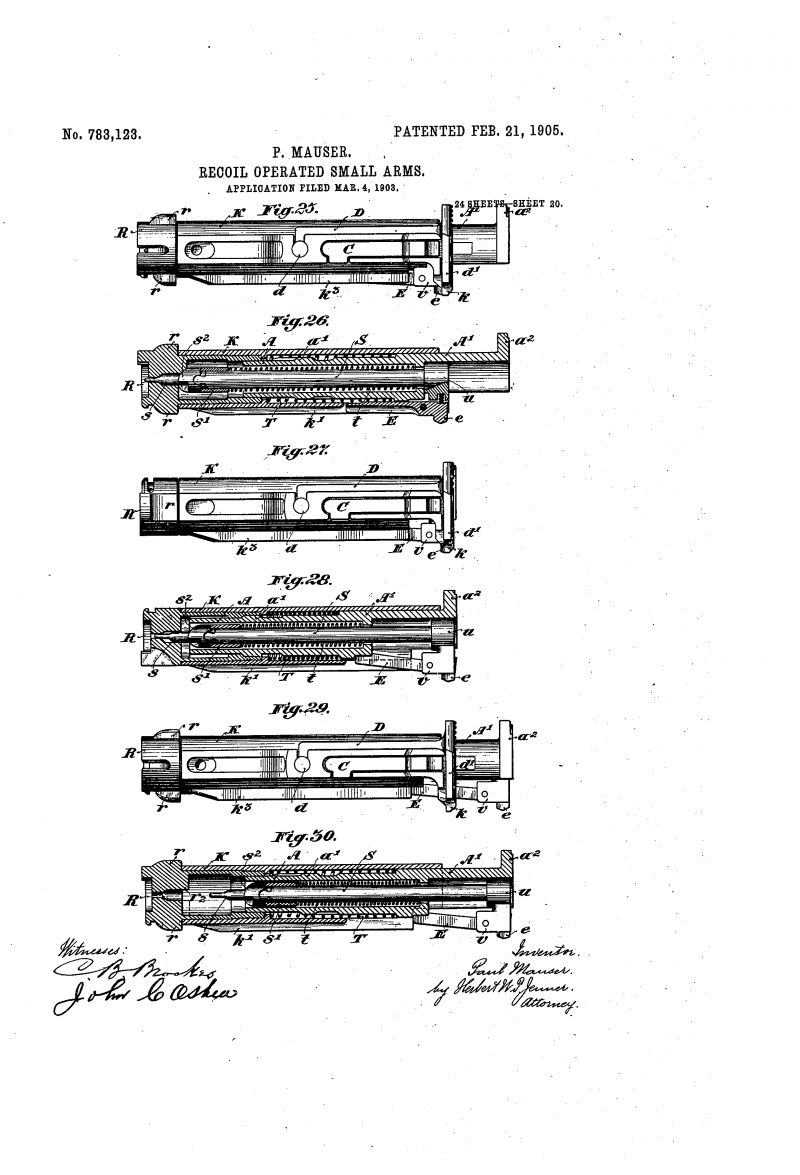
The design of the shutter and the position of parts at different stages of the recharge cycle. Patent drawing
After completion of the main work on the project 1902, PP Mauser has applied for patents in several countries. Over the next few years, the designer received all the necessary documents. Thus, the US patent number US 783123A had to wait until the beginning of the year 1905. It was this delay of the foreign patent office that later led to the appearance of the designation M1905.
After completion of the work on the rifle arr. 1902, Peter Paul Mauser continued to develop new versions of self-loading weapons. The next rifle of this class, created by him, was the product M1906. In 1908, it underwent a certain modernization, after which it was proposed to a potential customer in the person of the German army. According to reports, this was the first case of a proposal to the German military for self-loading small arms.
The M1902 / 1905 project was the first attempt of the German designer to create a rifle with automatic recoil based on the barrel with a long stroke. This attempt ended in limited success. P.P. Mauser successfully managed to develop and bring to the test a new design, but things did not go further. The project needed further improvement and could hardly be of interest from the point of view of real practical application. Work on the development of weapons were continued.
On the materials of the sites:
//forgottenweapons.com/
//sportsmansvintagepress.com/
//google.com/patents/US783123
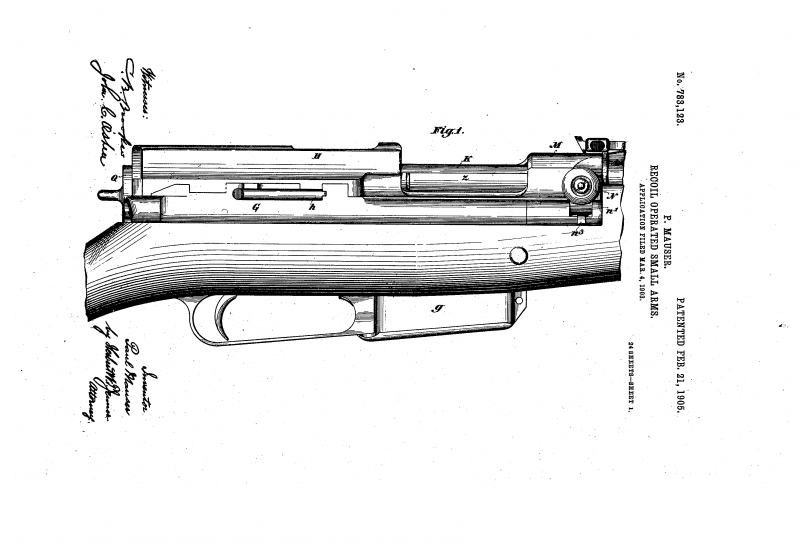
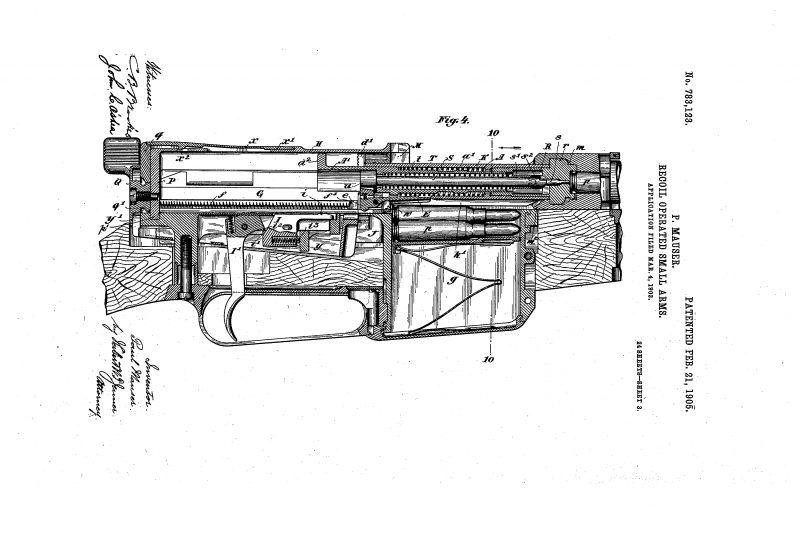
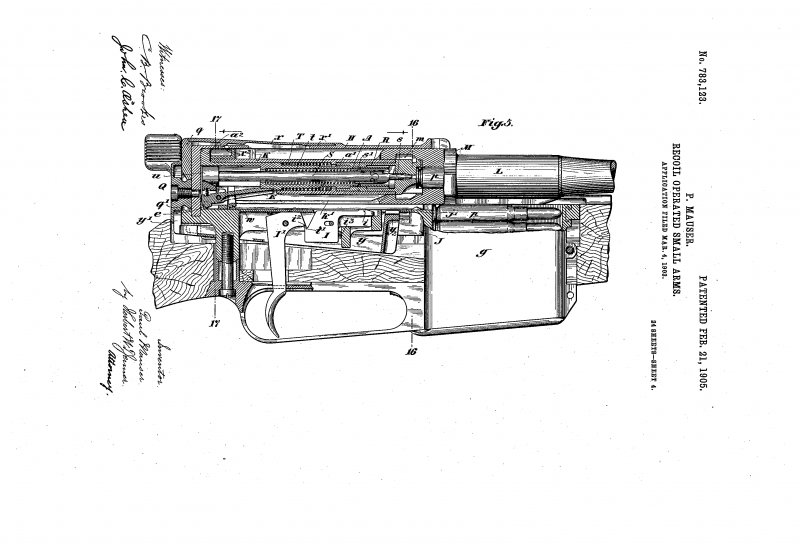
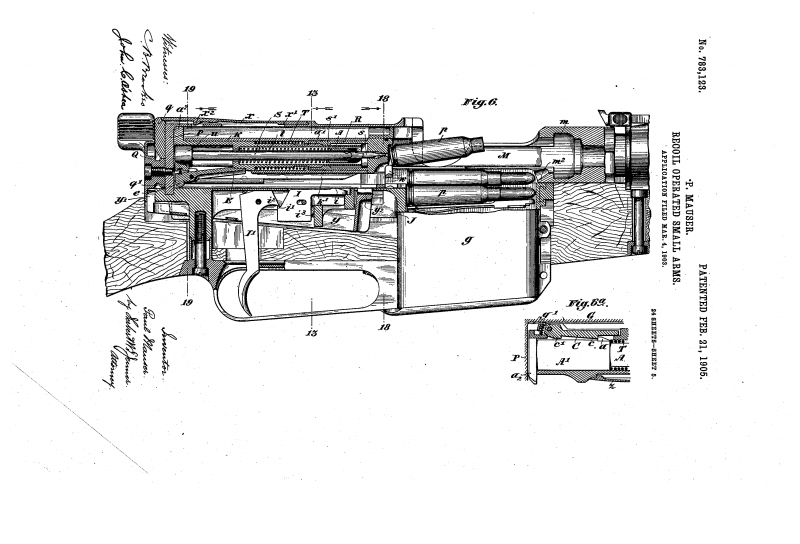
Information